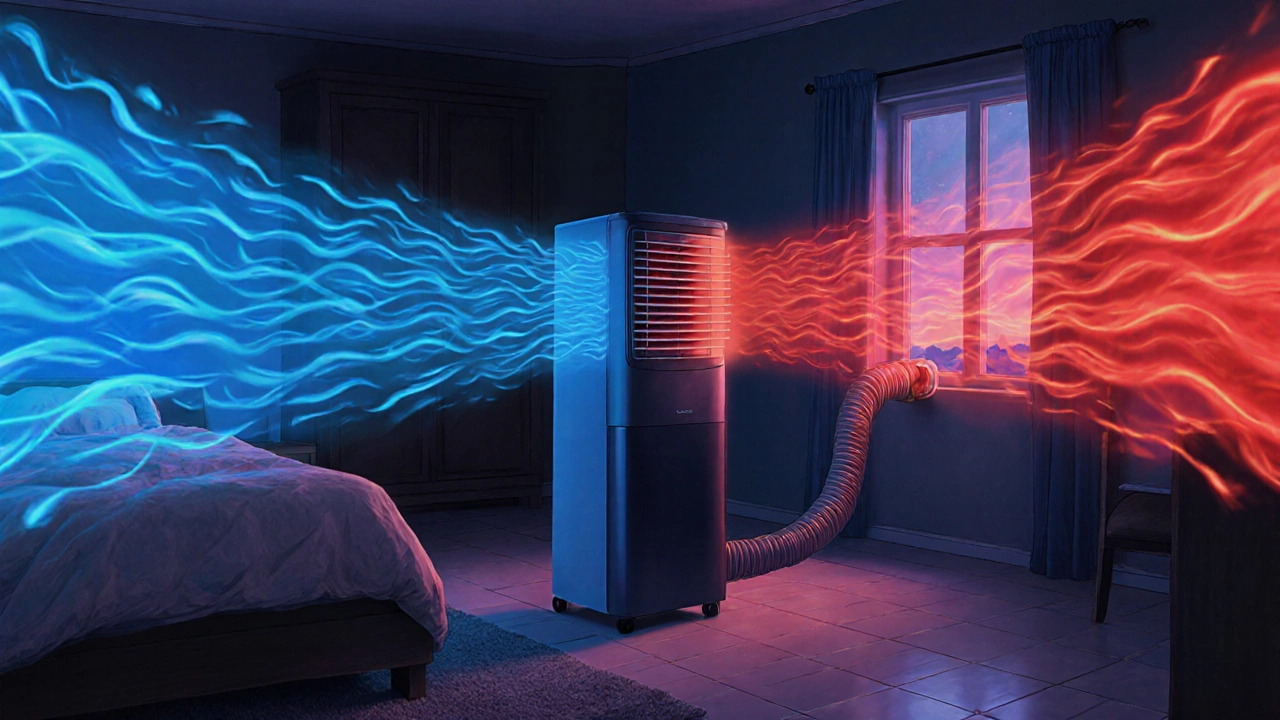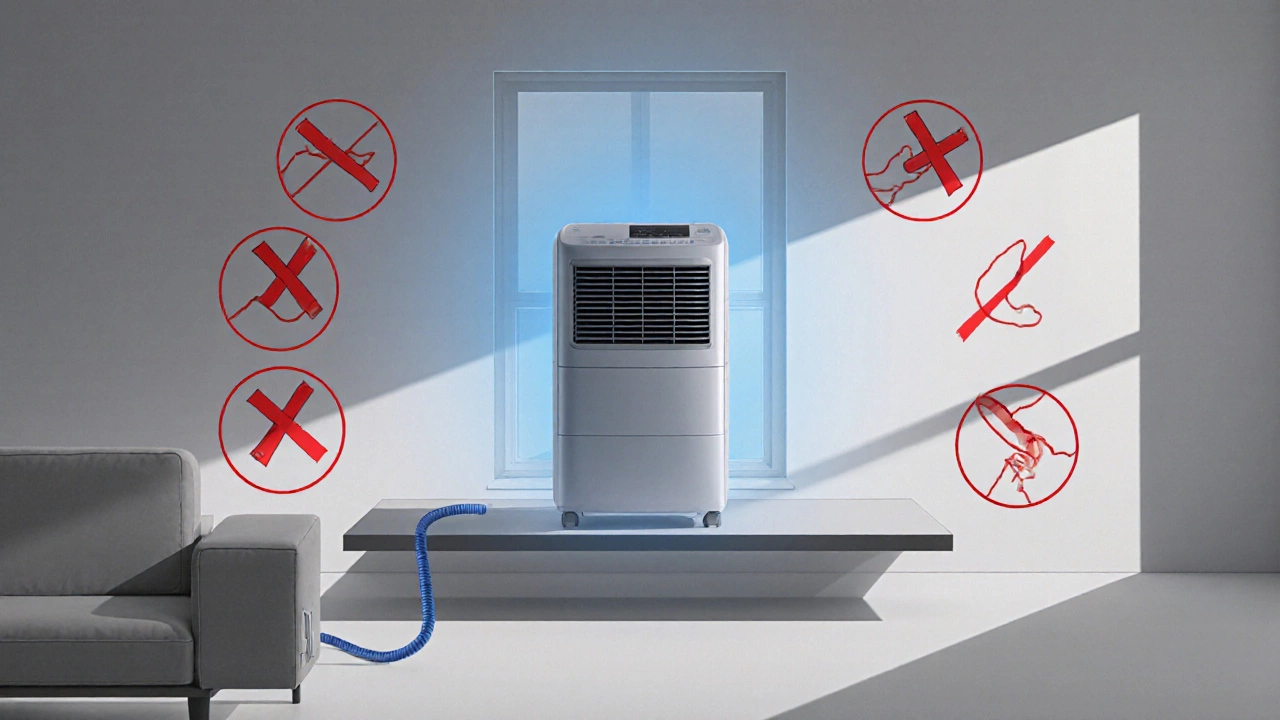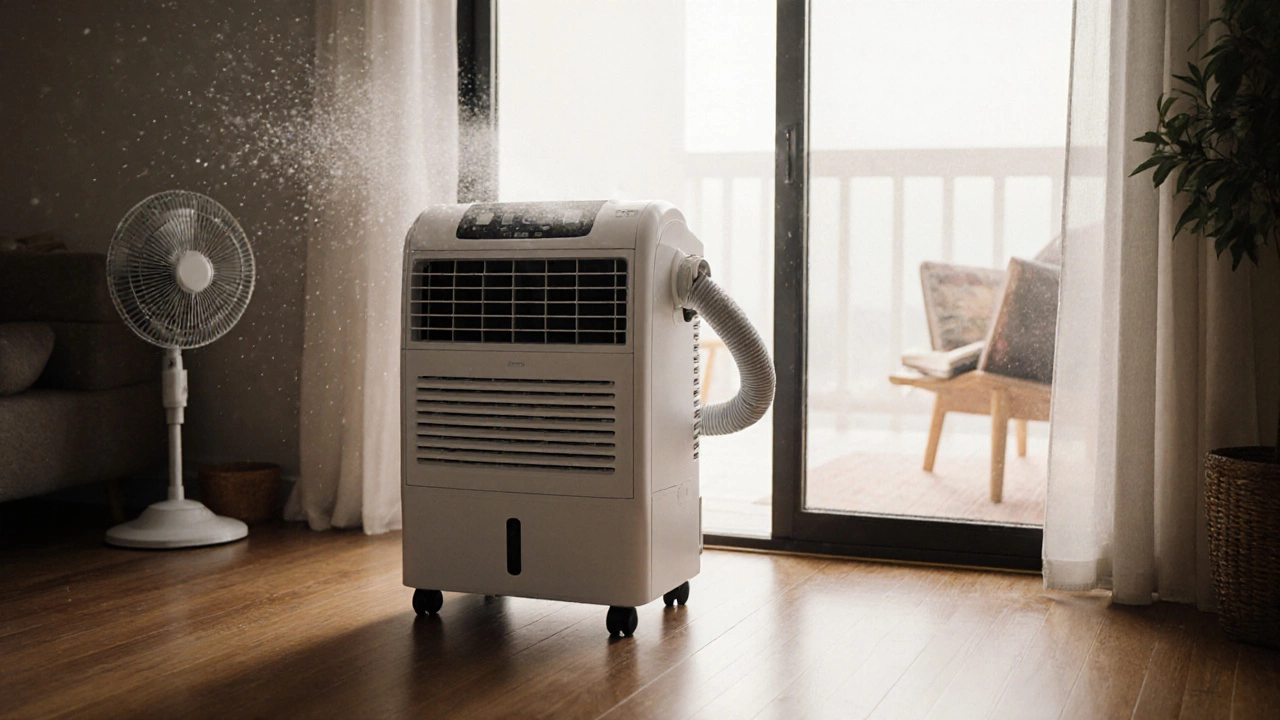Portable AC Placement Calculator
Optimize Your Cooling
Enter your room details and placement factors to get a personalized cooling efficiency score.
Putting a portable air conditioner in the wrong spot can turn your cool retreat into a hot mess. You bought it to beat the heat, but if it’s stuck in a corner with no airflow or blocked by curtains, it’s just wasting electricity and making your room feel stuffy. The truth? Where you put it matters more than the brand or BTU rating.
Keep It Near a Window or Door
The single most important rule for a portable air conditioner is: it needs to vent hot air outside. That’s how it works - it pulls warm air in, cools it, and dumps the leftover heat out through a hose. If that hose can’t reach a window or door, the unit will struggle. Most models come with a window kit, but even the best kit won’t fix a bad location.
Look for a window that opens wide enough for the exhaust hose. Sliding glass doors work great too. Avoid placing it in a room with no external access - like a closet or interior bathroom. Some people try to vent into the attic or through a dryer vent, but that’s risky. Attics get hotter than your living room, and dryer vents aren’t designed for AC exhaust. You’ll end up recycling hot air back into the room.
Avoid Tight Corners and Crowded Spaces
Portable ACs need breathing room. Don’t tuck it behind a sofa, under a table, or right next to a bookshelf. These units pull in air from the front and sides. If airflow is blocked, the evaporator coil freezes up, the compressor works harder, and your electricity bill spikes. I’ve seen people put theirs in a corner of a small bedroom and wonder why it never cools the whole space. It’s not the unit’s fault - it’s the location.
Leave at least 12 inches of space on all sides, especially the front and back. That gives the unit enough room to draw in warm air and push out cooled air. Think of it like a person trying to run in a narrow hallway - it’s possible, but it’s exhausting and inefficient.
Put It on a Hard, Level Surface
Never set your portable AC on carpet or a rug. These units have condensate tanks that collect water from the air. If the unit tilts even slightly, water can spill out. Carpet soaks it up, creates mold, and smells bad. Hardwood, tile, or laminate floors are ideal. If you must place it on a rug, use a plastic tray or a small mat designed for appliances to catch drips.
Also, make sure the floor is level. An uneven surface can cause the internal pump to malfunction. You might hear gurgling or notice water leaking from the bottom. It’s not a defect - it’s physics. Gravity still works, even in 2025.
Don’t Block the Air Intake or Output
Your portable AC has two air paths: one to suck in room air, and one to blow out cooled air. The intake is usually on the front or sides. The output is the exhaust hose. If you put a curtain, blanket, or even a plant in front of it, you’re cutting off its supply line.
One common mistake I’ve seen: people place the unit near a window but then pull the blinds down over the hose. That traps heat right next to the unit. The exhaust hose should stick out into the open air, not be sandwiched between window frames or covered by fabric. Keep the hose straight - no kinks. A bent hose restricts airflow and forces the motor to work overtime.

Place It Close to the Area You Use Most
Portable air conditioners don’t cool entire houses. They’re designed for single rooms. So put it where you spend the most time. If you work from home at your desk, place it near there. If you sleep with the door open and the fan on, put it in the bedroom. Don’t try to cool the whole apartment from the living room - it won’t work.
Think of it like a space heater. You wouldn’t put it in the basement to warm the upstairs. Same logic applies here. A 10,000 BTU unit can handle about 300 square feet, but only if it’s in the right spot. If you’re trying to cool a 500-square-foot open-plan space, you’re asking too much. Either get a bigger unit or split the space with two units.
Keep It Away from Direct Sunlight and Heat Sources
Even though it’s an air conditioner, your unit doesn’t like heat. Don’t place it next to a stove, oven, or a window that gets direct afternoon sun. That extra heat forces the unit to work harder to cool the air around it. You’ll notice it runs longer, cycles on and off more often, and still doesn’t feel cold enough.
Try to find a shaded spot in the room. If your best window gets sun all day, consider using blackout curtains on the window where the hose exits. That keeps the hot air from bouncing back into the room. It’s a small trick, but it makes a difference.
Don’t Forget About Humidity
Portable ACs also remove moisture from the air. That’s why you’ll see water collecting in the tank. If you live in a humid place like Vancouver, this is a good thing - dry air feels cooler. But if you put the unit in a very dry room, like a basement with a dehumidifier running, it might shut off early because the tank fills up faster than you expect.
Check the manual for how often you need to empty the tank. Some models have auto-evaporation, which reduces the need for emptying, but they still need proper airflow to work. If you’re draining it every few hours, you might need to move it to a more humid spot or switch to a model with a continuous drain option.

What Not to Do
- Don’t use it in a room with no windows or ventilation.
- Don’t extend the exhaust hose beyond the manufacturer’s limit - usually 5 to 7 feet.
- Don’t place it near electronics like TVs or computers. The moisture can damage them over time.
- Don’t leave it running all day in an empty room. It’s not a thermostat - it cools the air, not the space.
Real-World Example: My Vancouver Apartment
Last summer, I had a 12,000 BTU portable unit in my 600-square-foot one-bedroom. I tried putting it in the living room first. The bedroom stayed warm. Then I moved it to the bedroom, near the window, with the door open. The temperature dropped 8°F in 20 minutes. The living room stayed warm, but I wasn’t using it much. I didn’t need to cool the whole place - just where I slept.
I also kept a small fan near the unit to help circulate air. That made the cooling feel even faster. No fancy tech - just smart placement.
Final Tip: Test and Adjust
There’s no perfect spot on paper. Every room is different. Set up the unit, turn it on, and wait 30 minutes. Walk around. Check the corners. Feel the airflow. If the far side of the room still feels warm, try moving it a foot closer to the center. Maybe angle the unit slightly toward the hottest spot. Small changes make big differences.
Portable air conditioners are flexible. That’s why they’re popular. But flexibility means you have to pay attention. Don’t just plug it in and forget it. A little thought goes a long way.
Can I use a portable air conditioner in a room without a window?
No, not effectively. Portable air conditioners must vent hot air outside. Without a window, door, or other direct exit to the outdoors, the unit will recirculate warm air and fail to cool the room. Some people try to vent into attics, crawl spaces, or through walls, but these methods often lead to overheating, moisture buildup, or fire hazards. If your room has no window, consider a ductless mini-split or a fan with a dehumidifier instead.
How far can the exhaust hose be extended?
Most manufacturers limit the exhaust hose to 5 to 7 feet. Extending it beyond that reduces airflow, makes the unit work harder, and can cause overheating. If you need more reach, buy a model with a longer hose or reposition the unit closer to the window. Avoid using aftermarket extension kits - they’re often poorly sealed and leak hot air back into the room.
Why does my portable AC leak water?
Water leakage usually happens because the unit isn’t level, the drain hose is clogged, or the condensate tank is full. Make sure the unit sits flat on a hard surface. If it has a continuous drain option, connect a hose to drain it into a sink or floor drain. If it uses a tank, empty it regularly - every 6 to 8 hours in humid conditions. Mold or debris in the drain line can also cause backups, so clean it every few weeks.
Should I close doors and windows when using a portable AC?
Yes, but only the ones in the room you’re cooling. Keep the door to the room closed to trap cool air inside. Open windows in other rooms can let in warm, humid air, making the AC work harder. However, never close the window where the exhaust hose is installed - that’s where the heat escapes. If you’re using a window kit, make sure it’s sealed tightly to prevent air leaks.
Can I use a portable air conditioner all night?
Yes, as long as the unit is properly vented and the room is sealed. Most modern portable ACs have quiet modes and auto-shutoff timers. But if the unit is too small for the room, it will run nonstop, which can be noisy and increase energy use. Check the BTU rating - for a typical bedroom (100-150 sq ft), 8,000 to 10,000 BTU is enough. Also, empty the water tank before bed if your model doesn’t auto-evaporate.
If you’re still unsure, start simple: place the unit near a window, leave space around it, and test it for a day. Move it once if needed. You don’t need a degree in engineering - just common sense and a little patience.

